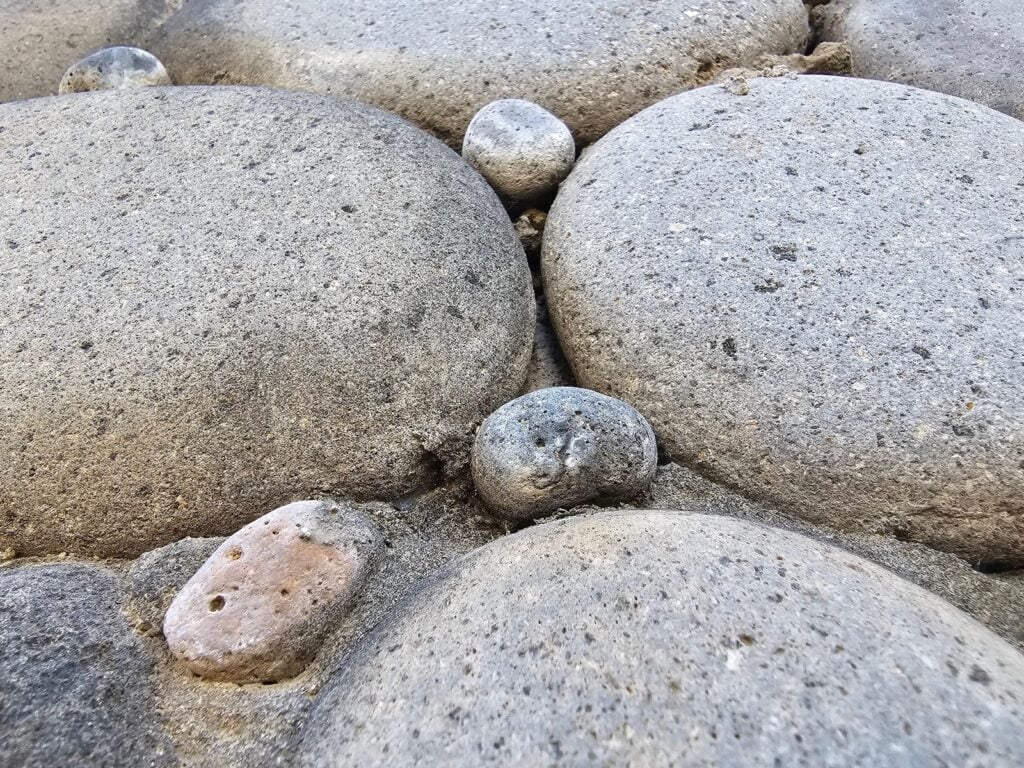Rounded rubble stone for classic masonry style
Here on our website and blog, we’ve looked at tons of different types of masonry. One of the most common historic types of walls is rubble masonry. It was definitely the cheapest options, used more for the simple sake of utility and way less refined and fancy, even back in historic times than the much more laborious ashlar masonry walls.
Ashlar stone has been cut to a rectilinear form, basically, and is set more similar to the way that brick is set in a wall with other units of masonry of similar or same sizing. Ashlar stone isn’t always exactly the same size. In some cases, ashlar stones can be set on the same course in the wall yet have different heights, and the next successive course above will have to accommodate those variations in the height of the substrate course.
The exterior walls that we are looking at in the series of photos below appear to be very similar to one another. However, in actuality, they are from several different locations. When we look closely to show these details, you’ll see the differences and although they may not be obvious from a difference, these differences take root in the methodologies of construction and the decisions related on the design.

By comparison, rubble masonry is almost completely randomized. Every stone has to fit between the adjacent stones on all sides. So you can think of rubble a bit more like puzzle work, but when it’s rounded rocks, like the stone masonry shown below, it’s a little bit easier to install. In most cases this rounded stone is intended to have relatively large gaps at the corners where it meets the other adjacent stones.
Therein, the only real challenge in sizing and culling or selecting of the stones to be used in each specific spot is based on sizing and without significant consideration of the other details of the shape of the stone because there’s general consistency throughout, with almost all of them having a near-rounded type shape.

You can see those large spaces of mortar here between the stones as you look closer in the photos above and below. If these rocks had come from a river or stream, they might be referred to as river rock, but here, even though they’re large, they’re called sea pebbles.
When we think of pebbles, we think of very small stones, but the term sea pebbles is often used to describe these type of stones, even when they’re large, even over 6 inches in diameter. River rock and sea pebbles are similar, as we mentioned, and they may even come from the same type of or similar type of rock. In this case, this particular stone happens to be granite which we often see far from the ocean, in the inner lands near old mountain ranges here on the east coast of the United States.

One of the differences though between river rock and sea pebbles is that sea pebbles are often a bit flatter. They’re obviously still rounded, but the oval shape of the stone can often be a little more shallow whereas river rock might be a little bit more fully round, not just in a two-dimensional circle but also in a three-dimensional shape, more like the shape of a ball.
In the next blog article, this coming week, we’re going to look at other pictures of different walls with similar types of installation but with some subtle differences that are important to really understand the finer details of the masonry construction.
Also, in the title of this article series, you may have noticed that we refer to this type of stone as decorative. In some circumstances, this type of stone can be used as a structural masonry, in a self-supporting wall, but in other cases such as some of the examples we’re going to show this coming week, this stone is used just as a covering to a brick masonry substrate which makes it a purely decorative type of application.
We can Help
Our company focuses on historic restoration more than modern building upkeep, maintenance, and construction, but our company understands both types of construction very well and a full picture well-rounded approach is needed in any niche in the construction industry. Although we focus on historic restoration, repointing, tuckpointing and historic brick repair, our company also has technical knowledge and competencies in the areas of modern and contemporary construction as well as we become one of the leaders in that area of the market today. Understanding both historic and modern or contemporary construction is useful because both aspects help understand the challenges and potential solutions for challenges in building science and construction.
We can help with a variety of historic masonry restoration needs and upkeep, from modest tuckpointing and or repointing to complicated and extensive historic masonry restoration. Infinity Design Solutions is a historic restoration specialist contractor specializing in both historic masonry restoration such as tuckpointing our repointing, and brick repair. If you have questions about the architectural details or facade of your historic building in Washington DC, reach out and say hello and if we can help we’ll be glad to assist you. You can email us or call us on the telephone at the following link: contact us here.
